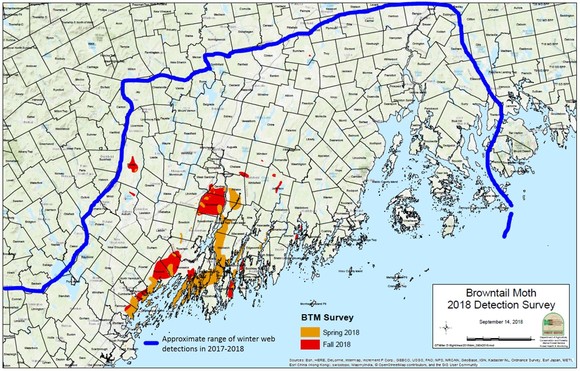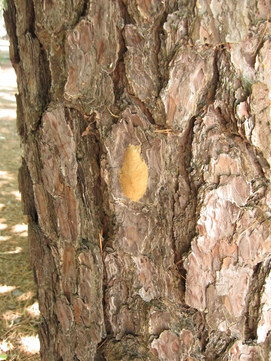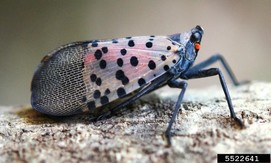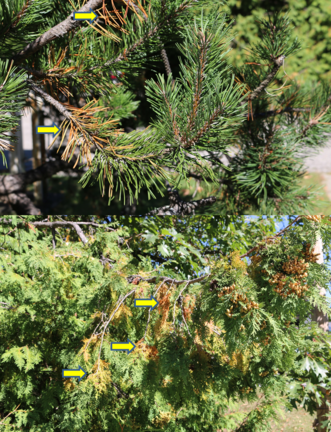Insect & Disease Conditions Update
A printer-friendly version of this report is available on-line from the Conditions Report Index. This is the last
planned Conditions Report bulletin of 2018. You may receive additional
electronic bulletins from time to time before April of next year. More limited
information will be shared with paper subscribers during the “off-season.”
We are pleased to welcome Thomas Schmeelk (rhymes with ‘elk’) to the
Entomology Lab in Augusta. Tom fills the position vacated in February with the
retirement of Charlene Donahue. He most recently worked for the State of New
York Forest Health Diagnostics Lab where he responded to client inquiries and
worked on programs involving a variety of pests including Asian longhorn
beetle, emerald ash borer, thousand cankers disease, southern pine beetle and Ips spp. He received a Master of Science
Degree in Entomology from The University of Illinois, where he studied native
longhorned beetle ecology. Tom’s experiences in New York will serve him and us
well in his new position with the Maine Forest Service. Please join us in
welcoming Tom to Maine.
Allison Kanoti is in temporary Acting Capacity
as State Entomologist. With this, there is still effectively a continued
reduction in staffing. Please be understanding in regard to any delay in
responses to inquiries, and don’t be shy about reiterating a request for
assistance.
Boxelder Bugs (Boisea trivittata) – Several
calls have come in regarding swarms of boxelder bugs. From www.gotpests.org: “Boxelder bugs normally feed on leaves, flowers and seed pods of
boxelder trees and other trees of the maple family. They cause little damage to
their host plant, usually only distorted leaves or damaged seeds. They are
considered a pest because they congregate in large numbers, trying to get into
homes and structures in the fall, and trying to get out of homes and structures
in the spring. They produce no odor and do not damage or injure wood, cloth,
fruits, vegetables, humans or pets.”
Other nuisance home invaders (this list not native to Maine) such as
western conifer seed bugs, Asian lady beetles and the newer arrival, brown
marmorated stink bug, may also be trying to move in soon. Sealing windows and installing
screens are your best defenses against these insects. Be aware that some of
these listed insects emit a foul odor when harassed. You can find more
information at www.gotpests.org.
Browntail Moth (Euproctis chrysorrhoea)
– The late-summer defoliation caused by early-instar browntail moth larvae has
been quite apparent throughout parts of southern Maine this year. The map below
shows what was visible during aerial survey, but additional spots could be seen
from the ground including small patches along the I-95 corridor from Auburn to
West Gardiner. This only represents the locations of the highest populations of
the insect. Webs were seen in the winter of 2018 from Deer Isle (Hancock
County), inland to Eddington (Penobscot County), and west to Parsonsfield (York
County).
Regardless
of where you live and work in Maine, please be on the lookout for overwintering
webs of this insect. Because of the human nuisance factor and potential health
impacts, we try to provide the public with information about where this pest
has been found. However, given the limits of our resources and difficulties in
detecting low populations, you are an important part of the detection network
for this invasive pest (and many others). In addition, we recommend management
of small populations to help forestall the need to treat larger areas. You can
find more information about browntail moth, including how to recognize winter
webs and where we saw webs in 2017–2018 at www.maine.gov/dacf/mfs/forest_health/invasive_threats/browntail_moth_info.htm.
Three talks have already been
scheduled to help the public in affected areas become more familiar with how to
identify, manage and live with browntail moth (see calendar below). Additional
talks will be scheduled and advertised on-line on the department website and
through other Maine Forest Service lists.

Emerald Ash Borer (Agrilus planipennis) – New Hampshire has just suspended their
internal quarantine for emerald ash borer. What does that mean for Maine? Ash
coming from all areas of New Hampshire is now considered regulated, as are
mixed-hardwood chips. Ash wood products from that area, such as logs, pulp and
chips, need to be accompanied by a certificate from USDA Animal and Plant Health
Inspection Service (APHIS). Regulated ash from out-of-state needs to go to a
receiver that holds a compliance agreement from USDA APHIS.
In September, we announced that
several ash trees shipped in violation of the federal quarantine had been sold
by a national chain in Maine. Those trees are still “at large.” In general, with the threat of EAB, ash is not
a wise choice for planting. People planting ash must understand that once EAB is found in the
planting location, the trees will require long-term periodic insecticide
treatment to survive. It is not advised that these
treatments start until emerald ash borer is confirmed within 10 miles of ash
trees. Details of the shipment are available at: https://content.govdelivery.com/accounts/MEDACF/bulletins/20b1b74. Information about protecting high-value ash trees can be found
at www.maine.gov/eab.
During the winter, until the trees
start to leaf out in the spring, the evidence of woodpeckers foraging for and
feeding on overwintering EAB larvae is most visible. As the birds forage, they
flick off the gray outer bark, and expose the light-blond inner bark, leaving a
distinctive signature (this is also sometimes seen associated with woodpeckers
feeding on native insects). It is primarily the smaller woodpeckers, like the
hairy and the downy, that feed on EAB, although even smaller birds like
nuthatches do as well. When you are out and about, watch for signs of
woodpecker feeding on ash and let us know if you see any. If you can, take a
picture of any feeding you see on ash and pass it on to us.
We encourage subscribers interested in getting all the department
announcements about emerald ash borer (EAB) to sign up for the topic “Emerald
Ash Borer (EAB)” on the department’s e-mail/SMS subscription service: https://public.govdelivery.com/accounts/MEDACF/subscriber/new. Department
staff from the Commissioner’s Office and two bureaus contribute to that topic,
therefore posts do not always reach Maine Forest Service Conditions Reports
subscribers. The EAB topic postings can be received as SMS messages (text to a
cellular phone) or by e-mail.
Please refer to the latest emerald ash borer
update for additional information about this pest in the region https://content.govdelivery.com/accounts/MEDACF/bulletins/21130c4. You can find more resources regarding emerald
ash borer in Maine at www.maine.gov/eab.
 Gypsy Moth (Lymantria dispar) – The gypsy moth is a
pest of quarantine significance in Maine. Each year the Maine Forest Service
and USDA APHIS conduct a joint survey for gypsy moth in the area of the state
not yet subject to regulations for this pest. This year, the cooperators
deployed more than 500 milk carton traps in northern and western Maine. In
years past, we have detected new reproducing populations of gypsy moth, causing
a need for revision of state quarantine rules. The process for revision has been started, and full
information about the proposal will be posted to the Secretary of State’s
office on October 24th at https://www.maine.gov/sos/cec/rules/notices.html/. A public hearing has been scheduled for November 14th
in Ashland, ME (details can be found in the Calendar section of this report).
Photo: Gypsy moth egg mass on a red pine. Maine Forest Service.
Several reports of light
defoliation caused by gypsy moth have been received by our offices. With the
continued dry conditions and outbreaks in southern New England, this is a pest
worth watching. This time of year, look for tan egg masses on just about
anything. If you are finding lots of egg masses (more than you can count on
your fingers) around your home, let us know. Photos and information about location,
the number of masses, the size of the plot of land where masses are found are all
of interest. Your information can help us focus survey efforts to areas we
might not otherwise visit. Please let us know if you think you have found egg
masses outside the gypsy moth quarantine area. Photos and information can be
sent to allison.m.kanoti@maine.gov or
call (207) 827-1813.
|
Minute Pirate
Bug (Orius spp.) or Cinch Bug (Blissus spp.)–A case of mistaken identity. While the first of the flood of
calls re. minute pirate bugs reported in the last bulletin was correctly
identified (they were sucking aphids dry on someone’s peach plant), several
later calls were mistakenly attributed to this beneficial insect after that
first identification. The correct identification was cinch bug, a pest of turf
and some crops (https://www.maine.gov/dacf/php/gotpests/bugs/chinch-bugs.htm). According to the Pest Management Office of Cooperative
Extension, this was a banner year for cinch bugs. If you are uncertain of what
you are seeing, a clear, very close-up picture of the insect may help us with
identification. Otherwise, please collect a sample of the insects and send them
to us or to the Pest Management Office of Cooperative Extension.
 Tree-of-heaven (Ailanthus
altissima) / Spotted lanternfly
(Lycorma delicatula) – Spotted lanternfly (SLF) is an invasive insect native to
China, India and Vietnam that threatens agriculture as well as northeastern
forests. SLF was first found in Pennsylvania in 2014 and has the potential to
spread throughout the northeast. Current research indicates that SLF requires a
meal from tree-of-heaven (which itself is a non-native invasive) to complete
its lifecycle. SLF may require this meal to sequester chemicals from tree-of-heaven
that allow it to protect itself from predators.
Photo: Spotted
lanternfly is an invasive insect that has potential to spread throughout the
northeast. Lawrence Barringer, Pennsylvania Department of Agriculture, Bugwood.org
|
Surveys for SLF are being conducted in Maine by DACF personnel through the Cooperative Agricultural Pest Survey Program, https://www.maine.gov/dacf/php/caps/index.shtml. The risk from SLF may be low in areas without tree-of-heaven. We would like to know where in Maine tree-of-heaven is, so we can better target surveys.
Tree-of-heaven can be identified by a combination of the following characteristics:
- Pinnately compound leaves (each leaf is comprised of multiple leaflets), 12–48” long, 10–40 leaflets on each leaf.
- SMOOTH leaf margins with 1–2 teeth at the base of each leaflet.
- Twigs have no terminal bud and the leaf scar is large and heart shaped.
- The bark of the tree is smooth and resembles a cantaloupe.
- The fruit is a samara.
Two common native trees that resemble tree-of-heaven are staghorn sumac and black walnut. Listed below are characteristics you can use to differentiate these species from tree-of-heaven. Note that black walnut and staghorn sumac both have serrated leaflet margins while tree-of-heaven has smooth leaflet margins.
-
Staghorn sumac: Pinnately compound leaves, 16–24”, SERRATED leaf margin, fruit is a red drupe, fuzzy twigs, bark smooth but with lenticels.
-
Black walnut: Pinnately compound leaves, 12–14”, SERRATED margin, has a terminal bud, bark rough with diamond-shaped patterns.
See more photos at https://gobotany.newenglandwild.org/species/ailanthus/altissima/).
*If you see tree-of-heaven, we’d like to know. You can enter sightings at https://login.imapinvasives.org/meimi/report_invasives/ or contact Nancy Olmstead at Nancy.Olmstead@Maine.gov
Photos: Clockwise from top left: Twig showing leaf scars and no terminal bud, compound leaf with smooth leaflet margins and 1–2 teeth at base, bark resembling cantaloupe, cluster of fruit (samaras). Bugwood.org: Daniel Herms, The Ohio State University. Karan A. Rawlins, University of Georgia. Annemarie Smith, ODNR Division of Forestry, Jan Samanek, Phytosanitary Administration.


Fall needle drop of conifers -
This time of year people may notice coniferous tree species shedding needles.
The needles on twigs and branches furthest toward the interior of the tree,
which are the oldest needles, begin to turn a pale-yellow to orange color
before dropping onto the ground, lawns, cars and driveways. Unless there are
clear signs of injury, wilting, sings of insect feeding or signs of fungal
infection (black spots or banding on needles), there is no cause for alarm.
This is very likely simply due to the natural phenomenon of seasonal needle
drop and not an insect or disease problem. Although conifer needle disease
incidence and severity has been high during the past few years, the premature needle
drop caused by those disease agents typically happens in June and July.
Photos: Orange inner foliage typical prior to seasonal needle drop by mugo pine (top); white cedar (bottom). Maine Forest Service
Unlike broad-leafed trees
(deciduous trees), conifers do not completely refoliate each year. Seasonal
needle drop in coniferous trees is a way for them to increase their efficiency.
The older needles are shed because they represent a greater energy cost in
terms of maintenance and defense than they generate through photosynthesis
compared to newer foliage. The energy that the tree no longer spends on
maintenance and defense of the older, shed needles is instead invested in growth,
maintenance and defense of more valuable tissues.
Seasonal needle drop can be
expected to be more noticeable in Maine this year, as more needle age classes
are shed due to the droughty summer conditions throughout most of the state. *Deciduous conifers like larch species and
dawn redwood will lose all their needles (leaves) in fall and refoliate each
spring.
|
For more information contact
287-2431
Oct 17, 2018, 6:00 pm, Falmouth Maine, Browntail Moth Public Information Session, for more details see
the Maine Forest Service Calendar: https://www.maine.gov/dacf/mfs/eventinfo.shtml?id=815305.
Oct 18, 2018, 10:30 am, Palermo Maine, Coping with the Browntail Moth, Sheepscot Lake Fish and Game Club,
1579 Route 3, Palermo, ME 04354. Hosted by Palermo’s Women’s Extension, all
welcome. Coffee beginning at 10:00. Full announcement on the Palermo Community
Library page: http://palermo.lib.me.us/.
Oct 18 2:00 pm – 4:00 pm, Boothbay Maine, Woodland Stewardship Tour with Knox-Lincoln Soil and Water
Conservation District, including a look at hemlock woolly adelgid More details at: https://content.govdelivery.com/accounts/MEDACF/bulletins/212fe1c.
Oct 29, 2018, 6:00 pm, Freeport Maine, Browntail Moth Public Information Session, for more details see the Maine Forest Service Calendar: https://www.maine.gov/dacf/mfs/eventinfo.shtml?id=815306.
Nov 14, 2018, 6:30 pm, Ashland Maine, Public Hearing for Proposed Revision of Chapter 271 Gypsy Moth
Quarantine, Maine Forest Service Regional Office, 45 Radar Road, Ashland Maine.
Details will be posted at the Secretary of State’s Website on October 24th
https://www.maine.gov/sos/cec/rules/notices.html/.
Nov 15, 2018, Madawaska Maine, Girdled Ash Trap Tree Log Peeling Workshop, Madawaska Municipal
Garage. Details to follow on Department’s EAB Topic (see body).
Early to mid-December 2018, Maine Forest
Service Foresters Institutes will focus on Forest Management
and Emerald Ash Borer. Details to follow on Department’s EAB Topic (see body).
Office hours are 7:30 am to 4:00 pm, Monday through
Friday, except for holidays. If you plan to visit either office, you may wish
to call ahead just to make sure someone will be present to meet with you. (207)
287-2431 (Augusta) and 827-1813 (Old Town)
Conditions
Report No. 4, 2018
On-line:
http://maine.gov/dacf/mfs/publications/condition_reports.html
Department of Agriculture Conservation & Forestry
Maine
Forest Service - Forest Health and Monitoring
Contributors:
Aaron Bergdahl, Allison Kanoti, Thomas Schmeelk and Colleen Teerling
|